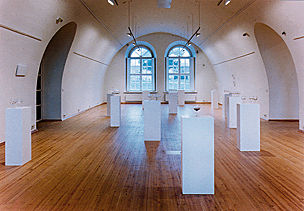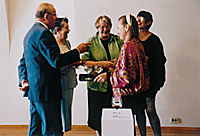

By Christiane Meyer-Stoll
On the front of the invitation card for Ólafur Gíslason’s exhibition at the Nordic Art Centre in Helsinki was the regular text which normally stands on the back of such cards; the back was empty. Indeed, this plain white paper surface, unillustrated and inviting all manner of interpretation and association, gave a particularly clear idea of the pending exhibition. White colourlessness also reigned supreme inside the exhibition room: the walls enclosing the exhibition space and the objects in it formed a whole which gave the impression that the objects on show, carefully cut white-lacquered rectagonal ashlars or pedestals, had stepped straight out from the exhibition space itself, its whitewashed neutral vaults and walls. This overall impression was the product not only of the common colour of the exhibition space and objects, but also of their inherent content: white rooms and white objects are, like invitation card, a neutral background to the event announced in the title of the exhibition: ‘Vernissage’, Opening of an Exhibition. The international rituals that govern such gatherings are the same everywhere: when an exhibition is opened, people gather to socialise, be seen and see others, and invariably keep hold of the same glass of the same white or red wine, thereby making the ritual into the occasion for the exhibition, even its formal and material constituents.
‘Vernissage’ consists of white-lacquered rectangular pedestals arranged here and there throughout two exhibition rooms, so that the viewer perceives the whole as an interactive spatial work. The white pedestals operate with a double effect: they are concrete and visible objects within the exhibition space and at the same time inspire a feeling of the opposite, of emptiness and expectation. Gíslason always works from the basic form of a white box, whose dimensions and height are chosen in ‘Vernissage’ so as to be ideal for standing glasses on or leaning up against. Nonetheless, Gíslason’s ‘stands’, in the exhibition context, unequivocally suggest the pedestals which, at best, enhance the effect of the works of art mounted on them but do not attract attention in their own right. It is this accepted attitude towards pedestals - looking at them without noticing them - which inspires a feeling that the actual exhibits are missing from the exhibition.
In addition to the ‘pedestals’, the wine glasses and their contents which are provided by the artist for the guests play an important role in ‘Vernissage’, serving as its second main material component. As with all Gíslason’s installations and other works, external impulses become the shaping force. The act of combining individual elements, the pedestals and glasses, was assigned to the invitees at the opening. At first they were inhibited by the accepted notion that works of art at museums were not to be touched, until a few bold guests broke the spell of the pristine emptiness and white surfaces.
Afterwards, other ‘creative guests’ continued to secularise the pedestals and transform them into basic still-lives of stray glasses and dregs of wine with cigarette butts and lumps of chewing gum which they arranged with varying degrees of artistry - deliberately or accidentally. For a viewer unaware of the genesis of the work, its arbitrary and highly mundane process of creation, the result may recall a modern transcription of the widespread memento mori themes of the seventeenth and eighteenth century still life.
The pictorial link with the still life unveils a deeper subject of ‘Vernissage’, namely the complex relationship between the ‘work of art’ and ‘everyday object’ which is a theme of almost all Ólafur Gíslason’s works. The conscious secularisation of a spatial work in one evening and its ‘result’, the final ‘creation’ by the guests which becomes art overnight, are really only one aspect of his complex theme. The apparent transformation of utensils into works of art does not primarily show the power and capriciousness of the artist, but rather the basis of conventional artistic activity, which is opposed to any process of transformation ‘Impure’, ‘random’ and created without the respectable endorsement of the artist, these works have a provocative force which does not manifest itself on the evening the exhibition opens, but instead in the context of a regular museum visit. They foil expectations of finding works of art which may not be moved or touched, the fossilised output of a creative artistic genius. In ‘Vernissage’, Ólafur Gíslason explores the actual process by which an art object is created, posing underlying fundamental questions about the definition of a work of art which have persisted ever since Duchamp first stated them. The installations which came into being on the first evening were precisely documented with drawings and photographs and each glass was marked, so that the pedestals and what stood on them could be exactly reconstructed when the exhibition ended. This detailed study brought one noticeable aspect of the opening even more clearly to light: while some of the arrangements were produced by the mundane act of placing glasses at random on a table, most of the pedestals supported spatial still lives, high towers of glasses which revealed the creative aspiration and competitive spirit of their ‘authors’, or lumps of chewing gum and cigarette butts which testified to their destructive urge. The guests’ signatures in the visitors’ book perfect this collective work of art - according to the traditional definition - which consists of the artist’s spatial work and the installation set up by the ‘visiting artists.’ ‘Vernissage’ is a study of the creative force of the everyday: Ólafur Gíslason’s white pedestals, hovering between the work of art and everyday objects, release this force, reciprocate it and establish it. In accordance with the rules of such inquiries, Ólafur Gíslason changed the starting-point for the guests at his ‘Vernissage’ in Copenhagen by exhibiting twelve pedestals with a reconstructed arrangement of the glasses from Helsinki. For this purpose he chose twelve constellations, sufficiently diverse to allow interpretation of different intentions and the atmosphere prevailing when they came into being. The installation of these ‘works’ in a new place, the construction of the spontaneous, immediately shifted the context of the pedestals on which the glasses stood, towards a traditional museum role. Underlining this ‘museum-like’ impression even more firmly, the glasses bore scientific-looking labels like, for example, the tags used for bird’s feet. The unambiguous definition of the white pedestals as supports for arrangements isolated them from encroachment by the guests, but despite these greater constraints, the isolation was broken as the opening evening progressed and the pedestals were used once more, and changed. The following day the now untouchable pedestal related the dialogue from the opening the preceding evening, with labelled glasses (Helsinki) and unlabelled (Copenhagen) side by side.
Another effect of the installation emerged on this occasion: the pedestals acted as a kind of point of measurement showing the distribution of the guests throughout the exhibition space. The guests has crowded around the entrance to the exhibition room and the majority of the fifty additional glasses were shared among the three pedestals which had been standing there. On the first day, a three-storey pyramid of glasses collapsed, on the most heavily laden pedestal by the entrance. The broken glass on the floor gave the spatial work a dramatic undertone for the remainder of the exhibition. The ‘Vernissage’ in Reykjavík uses the ‘raw material’ of the Helsinki pedestal arrangement in a different way from the Copenhagen exhibition. Ten reconstructed arrangements from Helsinki are isolated by enclosing the pedestals in two-metre-high plastic domes, which are not exhibition cases but rather an elementary device for creating a transparent space, closing and protecting the work from encroachment by visitors. Measuring 42.5 x 32.5 cm wide and two metres high, the plastic covers resemble human proportions which increases the emphasis given to each separate pedestal’s human and individual characteristics. The obvious grandeur and technological character of these tall glass cases and their effect on the surrounding space lend a new aspect to ‘Vernissage’ in Reykjavík, a question of authorship: the pedestals were made by the artist himself, the glass constellations were made by visitors to the exhibition, and the plastic covers were commercially produced. Ólafur Gíslason’s fundamental conception of ‘Vernissage’ creates the linkage between these elements. It will be interesting to see the interaction between this concept and the reactions of visitors to ‘Vernissage’ in Reykjavík, which has been envisaged but can never be exactly predicted.
The ‘Vernissage’ in Reykjavík catalogue, describing all the installations of the exhibitions so far, may be regarded as an exact documentation of the experiment’s progress up until the present time. The entire history, comprising dried dregs of wine and broken glasses, the precise location of a specific glass on a specific pedestal, will be revealed once again in its lost size and on a new reduced scale: Ólafur Gíslason´s ‘Vernissage’, the memento mori of the everyday.


|
|
|
|
|
|
|
|